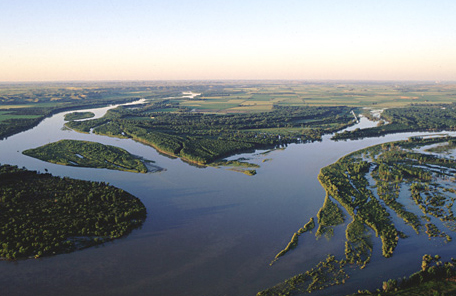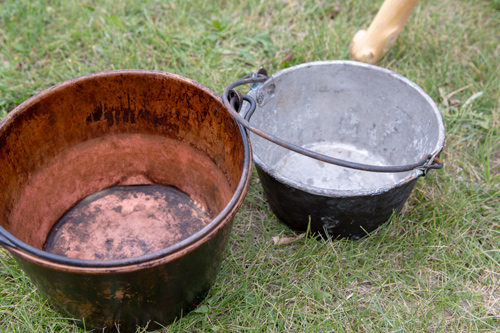Clark and his group reach the mouth of the Yellowstone and stop to dry everything at their old camp of 26 April 1805. The mosquitoes are so thick that Clark cannot shoot accurately, yet he recommends the site for a fur trade post.
Lewis and his group make seventy miles down the Missouri. To devote more time for paddling, he orders each mess to cook all they need for the next day. The hunting is good with 29 deer killed since yesterday morning.
Still on the Yellowstone, Sgt. Pryor and his group of three must navigate their small bull boats around the many bison crossing the river.[1]For more on the captains’ strategy and various groups after leaving Travelers’ Rest, see Dividing Forces at Travelers’ Rest.
New Mess Orders
by Yellowstone Public Radio[2]Originally aired weekdays by Yellowstone Public Radio during the Bicentennial observance of 2003-2006. Narrated by Hal Hansen. Scripts by Whit Hansen and Ed Jacobson. Produced by Leni Holliman. © … Continue reading
Clark Reaches the Missouri
Mosquitoes Obscure Sight
on the Side of this bluff I saw Some of the Mountain Bighorn animals. I assended the hill below the Bluff. the Musquetors were So noumerous that I could not Shute with any Certainty and therefore Soon returned to the Canoes.
—William Clark
Missouri-Yellowstone Confluence
I arived at the Junction of the Rochejhone with the Missouri, and formed my Camp imediately in the point between the two river at which place the party had all encamped the 26th of April—1805.
—William Clark
Drying Out
had the Canoes unloaded and every article exposed to dry & Sun. Maney of our things were wet, and nearly all the Store of meat which had been killed above Spoiled. I ordered it to be thrown into the river. Several Skins are also Spoiled which is a loss, as they are our principal dependance for Clothes to last us to our homes &c.
—William Clark
Proposed Fur Trade Post
to an establishment on this river at clarks Fork the Shoshones both within and West of the Rocky Mountains would willingly resort for the purposes of trade as they would in a great measure be relived from the fear of being attacked by their enimies the blackfoot [Blackfeet] Indians and Minnetares of fort de Prarie [Atsinas], which would most probably happen were they to visit any establishment which could be conveniently formed on the Missouri . . . . it may therefore be looked to as one of the most important establishments of the western fur trade.
—William Clark
Two Kettles
© 2018 by Kristopher K. Townsend. Permission to use granted under the Creative Commons Attribution-Share Alike 4.0 International license.
Lewis Cooks Less, Paddles More
An Early Start
I arrose early this morning and had the perogue and canoes loaded and set out at half after 6 A. M. . . . . we saw but few buffaloe in the course of this day, tho’ a greater number of Elk, deer, wolves, some bear, beaver, geese a few ducks, the party coloured covus, one Callamet Eagle, a number of bald Eagles, red headed woodpeckers &c.
—Meriwether Lewis
New Mess Orders
we did not halt today to cook and dine as usual having directed that in future the party should cook as much meat in the evening after encamping as would be sufficient to serve them the next day; by this means we forward our journey at least 12 or 15 miles Pr. day.
—Meriwether Lewis
Good Hunting
soon after we encamp Drewyer killed a fat doe. the Fieldses [Joseph Field and Reubin Field] arrived at dark with the flesh of two fine bucks, besides which they had killed two does since we passed them making in all 29 deer since yesterday morning. Collins and Colter did not overtake us this evening.
—Meriwether Lewis
Pryor Sees Many Buffalo
the buffaloe So pleanty and Swimming the [Yellowstone] river So that they could Scarsely pass down this river mountn. Sheep also in many places.
—John Ordway (recorded 12 August 1806)[3]Precise dates and locations for Pryor’s trip down the Yellowstone are not known. Pryor was instructed to keep a journal, but it if he did, it is lost.
Weather Diaries
State of the weather at rise
Wind at rise
State of the weather at 4 P. M. Wind at 4 P. M. fair S E fair S E —Meriwether Lewis
State of the weather at Sun rise State of wind at Sunrise State of the weather at 4 P. M. Wind at 4 P. M. State of river fair S W fair S W. rise 2 ¼ in. Musquetors troublesom. I arive at the Missouri. heavy dew.
—William Clark[4]To assist the reader of this web page, the date column is omitted, some abbreviations have been spelled out, and the three river columns have been merged.
Notes
| ↑1 | For more on the captains’ strategy and various groups after leaving Travelers’ Rest, see Dividing Forces at Travelers’ Rest. |
|---|---|
| ↑2 | Originally aired weekdays by Yellowstone Public Radio during the Bicentennial observance of 2003-2006. Narrated by Hal Hansen. Scripts by Whit Hansen and Ed Jacobson. Produced by Leni Holliman. © 2003 by Yellowstone Public Radio. |
| ↑3 | Precise dates and locations for Pryor’s trip down the Yellowstone are not known. Pryor was instructed to keep a journal, but it if he did, it is lost. |
| ↑4 | To assist the reader of this web page, the date column is omitted, some abbreviations have been spelled out, and the three river columns have been merged. |
Experience the Lewis and Clark Trail
The Lewis and Clark Trail Experience—our sister site at lewisandclark.travel—connects the world to people and places on the Lewis and Clark Trail.
Discover More
- The Lewis and Clark Expedition: Day by Day by Gary E. Moulton (University of Nebraska Press, 2018). The story in prose, 14 May 1804–23 September 1806.
- The Lewis and Clark Journals: An American Epic of Discovery (abridged) by Gary E. Moulton (University of Nebraska Press, 2003). Selected journal excerpts, 14 May 1804–23 September 1806.
- The Lewis and Clark Journals. by Gary E. Moulton (University of Nebraska Press, 1983–2001). The complete story in 13 volumes.



